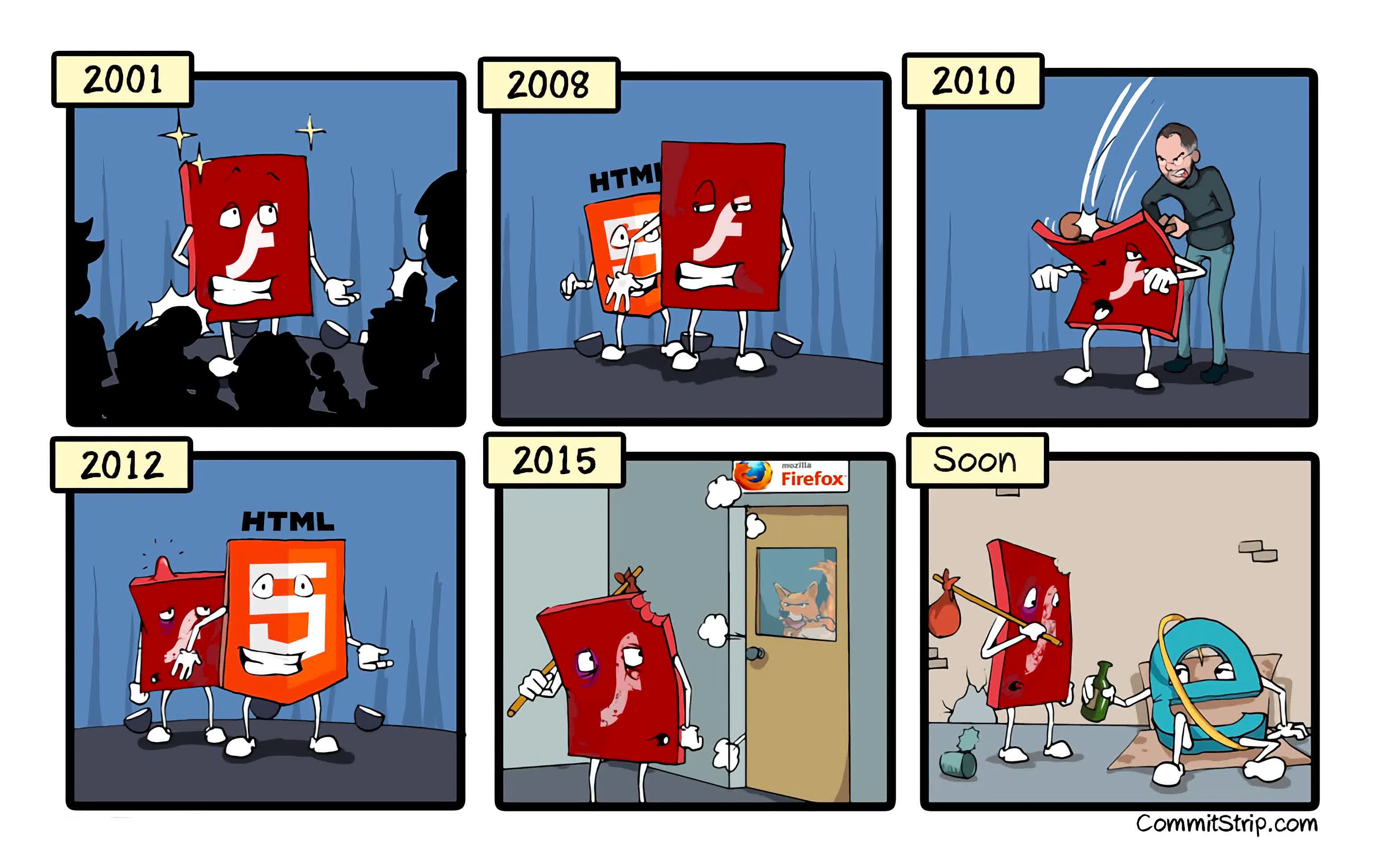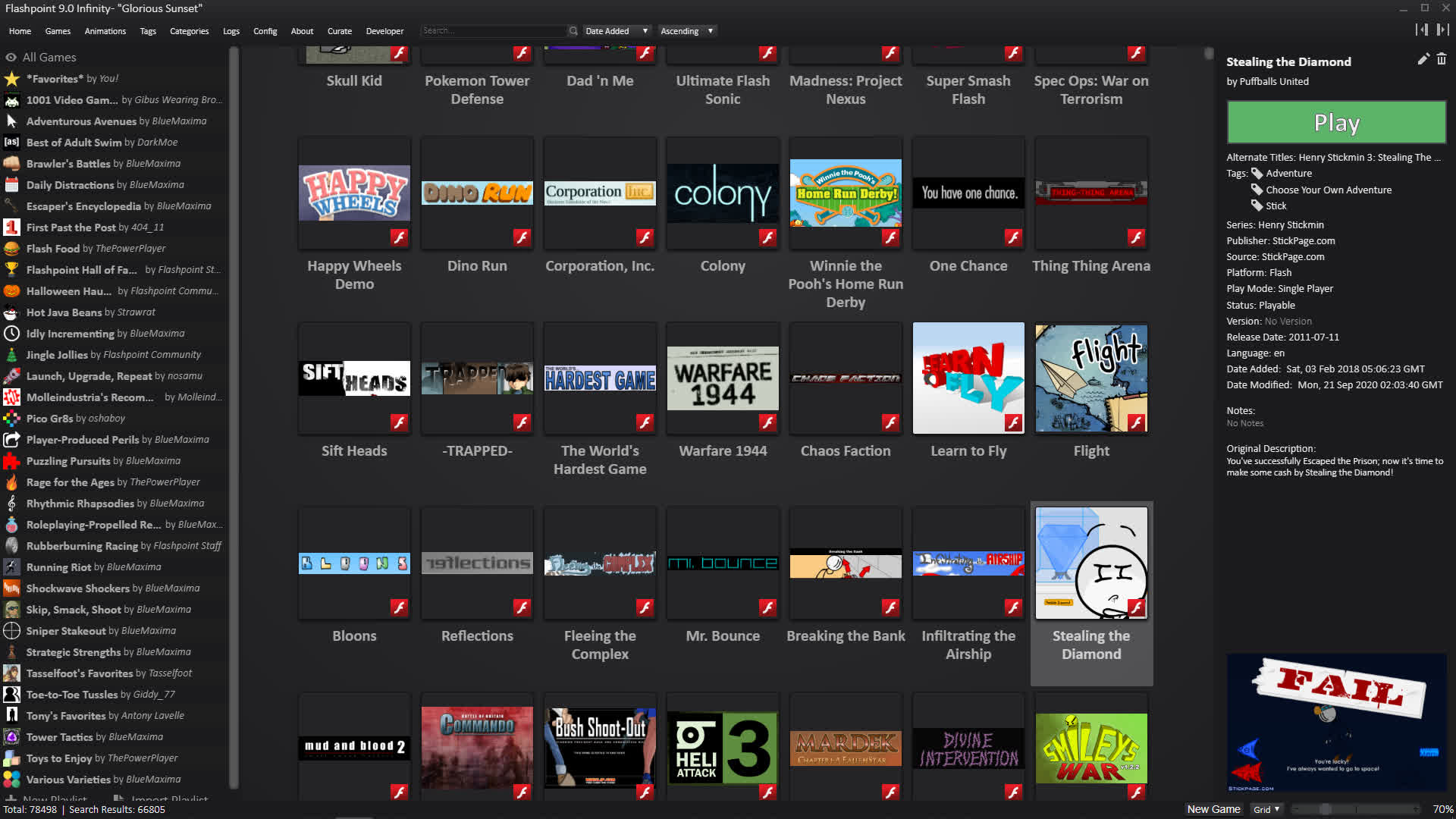Can I Upgrade Adobe Flash To Animate?
For many years, Adobe Flash was synonymous with blitheness on the web, browser games, and interactive websites. In 2011, the Wink Player plug-in was installed on 99% of desktop browsers in the Western world. One decade subsequently, no modern web browser supports Flash outside of Cathay.
In the 1990s, the net was growing rapidly, and web browsers could non go on up with the pace of new file types that were designed to be shared over it. That led to the development of plug-ins: small apps that weren't designed to work independently, but add functions to the browser, like browser extensions do today.
Video plug-ins such as Apple QuickTime and the Windows Media Role player showed video content that was made of private frames, somewhat similar to how animated GIFs work, but with the added capability of showing some of those frames while the residuum were downloading, and adding pinch to amend loading speed at the expense of quality.
In the era of dial-up modems, internet video was either of low resolution, despairingly dull to load, or both. In that kind of context, interactive videos that loaded quickly and fully utilized the resolution of every screen looked similar a miracle. This is the story of how a big part of the early web civilisation was formed.
Drawing a Future
In 1993, a company chosen FutureWave was founded by Charlie Jackson, Jonathan Gay and Michelle Welsh, releasing the SmartSketch drawing app for the PenPoint OS, which was one of the first operating systems for graphical tablets. SmartSketch created files based on vector graphics, similar to the modern SVG image format. In pocket-size tablets, it was important to exist able to create images that would wait the same when viewed on larger and college-resolution screens.
When PenPoint flopped, the app was ported to Mac and Windows. In 1995, FutureWave added blitheness capabilities to the app and released information technology as FutureSplash Animator. In an early ironic move, Adobe declined an offer to buy FutureWave that year.

The FutureSplash Histrion plug-in released in 1996 was a strong alternative to Macromedia's Shockwave Player, which had get available the year prior and was capable of playing heavier file types that were also used in CD-ROM games. Equally impressive equally it was, the scalable nature of FutureSplash videos wasn't the reason that they were seeing success. Rather, it was the ability to create surprisingly small files with the use of limited blitheness.
For showing an object moving on a static background, a FutureSplash file wouldn't need to include tens or hundreds of frames with the object in unlike places -- it only needed to include instructions to move the object. Inside hundreds of kilobytes, FutureSplash could create videos that were several minutes long.
Afterwards that year, Microsoft used FutureSplash in the carte du jour of MSN Program Viewer, a video streaming service that was years ahead of its time and failed quickly, making Microsoft completely abandon the concept. FutureSplash was later used in websites that were more successful at the time, including Disney Online and The Simpsons.
Interactive and Popular
Near the end of 1996, Macromedia acquired FutureWave, shortened the name FutureSplash to Wink, and re-released the FutureSplash Animator every bit Macromedia Flash.
The post-obit yr, Flash was used to create what's considered to be the beginning web-exclusive cartoon series: The Goddamn George Liquor Program, created past John Kricfalusi, known for The Ren & Stimpy Show. While more detailed than about Wink videos, information technology was even so surprisingly watchable on the internet. In 1999, Showtime's WhirlGirl became the first serial to be released simultaneously on a cable network and on the internet.
Adult-minded web cartoons such as Happy Tree Friends and Queer Duck later became Television receiver shows. Wink-based series that were broadcast on TV from the start include The Powerpuff Girls, My Little Pony: Friendship Is Magic, and Foster's Home for Imaginary Friends.
In the Macromedia era, Wink was getting more and more interactive. Ane popular case of that was "Frog in a Blender," released by Joe Cartoon in 1999, which was i of the first viral videos on the internet. The user was able to get dorsum and forth between the blender'southward first and 9th speed levels, merely switching to the 10th level would rapidly terminate the video (in Joe's defense, information technology was a very disrespectful frog).
A more impressive example of the same year was Pico's School, a betoken-and-click activity-adventure game inspired by the Columbine Loftier School massacre, adult by Tom Fulp and released on Newgrounds. The game turned Wink into a popular gaming platform, and Newgrounds into a fundamental browser gaming hub.
Macromedia Flash 5, released in 2000, was the first to officially support ActionScript, a programming language that enabled the creation of much more sophisticated games. Over the years, games similar Alien Hominid, Farmville, Club Penguin and the Meat Boy series started out using Wink.
Starting 2003, many mobile phones shipped with the Wink Lite app, which allowed them to play Wink content that was created with mobile platforms in mind.
In 2005, YouTube was launched, requiring the Flash Player to lookout man videos, even though the videos on the site weren't scalable or interactive in themselves. That yr, the plug-in was installed on more than 98% of PCs connected to the internet. By the end of that yr, Macromedia had been acquired past Adobe.
Bitten by an Apple

The first version of Adobe Flash was released in 2007 with improved Photoshop integration, and drawing tools that were like to those offered by Adobe Illustrator. That same twelvemonth, the starting time iPhone was launched with no Flash support. Despite being a fully fledged web browser (for a mobile device of that era), Safari did not back up Flash websites which were very mutual so. The iPhone could play YouTube videos within the dedicated app, thanks to Google converting videos to the H.264 format following the iPhone's proclamation.
The following year, HTML5 was released to the public, and was able to mimic Flash in sites coded using it without whatsoever plug-ins. That was accomplished with the integration of JavaScript, which enabled interactivity similar to ActionScript; and later with CSS3, which was used to brandish HTML pages in several dissimilar ways, and supported calculation SVG animations. One criticism of Flash was that as a plug-in, it could create cookies that the browser couldn't detect or remove.

Later in 2008, Adobe released its Integrated Systems evolution app, afterward chosen Adobe AIR, which enabled Flash content, such as games, to run inside defended apps, removing the need for Flash Lite.
Information technology took Adobe several years to create a fully functional mobile version of the Flash Player, and Steve Jobs wasn't willing to await. In 2010, post-obit the beginning iPad's announcement, the CEO famously published the Thoughts on Flash open alphabetic character, maxim that Apple'due south mobile devices would never support the plug-in, citing operation, security and bombardment-life issues.
Jobs added that interactive Wink elements would need to be rewritten anyway for mobile sites to compensate for the lack of a mouse. His merits that Wink was a "closed organisation" was criticized equally hypocritical, as the aforementioned could be said about iOS.
Most 2 months afterward the letter, YouTube switched to HTML5-based playback on mobile platforms. At offset, Apple didn't allow the development of Flash-based apps for iOS, only reversed that determination later on. The Flash Histrion did come to Android devices eventually, but the disappointing performance shed a more than positive light on Jobs' letter. In tardily 2011, Adobe halted the evolution of Flash Player for mobile devices.
On the desktop, Wink remained potent for several more years. By 2011 the Flash Player could utilize the GPU for 3D rendering using the Stage3D API, which launched a wave of 3D browser games and commercial demonstrations. JavaScript'southward respond to Stage3D was WebGL.
In 2015, YouTube switched to an HTML5-based player past default on all devices. The adjacent year, Adobe Flash was renamed Adobe Animate to disassociate information technology from the ill-blighted Flash Actor.
In 2017, Adobe appear that it would stop supporting Flash by the finish of 2020.
The Backwash

Following Adobe's announcement, all modern web browsers started blocking Flash content by default, with the block becoming entirely effective subsequently 2020. The concluding versions of Wink Player itself actually had a kill switch, which prevented them from running afterward Jan 12, 2021. Moreover, afterwards in 2021, Microsoft issued a mandatory update that removed Wink Role player from Windows.
The Chinese variant of Flash, which is used for showing ads and collecting personal data from users, is still developed past a company called Zhongcheng. In 2021, Adobe partnered with Harman, a Samsung subsidiary, to keep supporting Flash for enterprise users.
Several emulators were created to allow the playing of Flash content on HTML5 sites. The nigh successful of which is Ruffle, which is used past the Internet Archive and many others.
The Flashpoint project was created to preserve games and apps that relied on Wink Player and other browser plug-ins. So far, the project has grouped together over 100,000 such games, making them bachelor for offline play. You can download the primary app (3GB), which just downloads games when y'all cull to play them or the unabridged collection which weighs in at about 900GB.
Source: https://www.techspot.com/article/2413-adobe-flash/
Posted by: longcomem1980.blogspot.com

0 Response to "Can I Upgrade Adobe Flash To Animate?"
Post a Comment